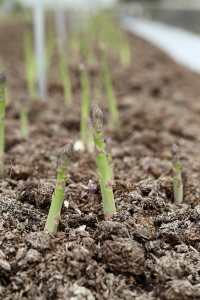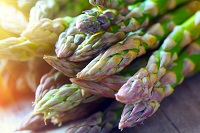
Asparagus is a perennial crop. If planted and managed properly, it can produce 15 years or more, a nice return on your investment! Soil preparation is key. Asparagus likes any well-drained soil. Fertile, sandy loam is preferable but it will grow in acidic heavy clay soil that has been conditioned with composted manures, mushroom compost or compost made in your backyard. Consider raised beds if you have heavy soils. The soil pH should be 6.5 to 6.7. A soil test 6 months before planting will give you time to build up the organic matter in your soil. Research shows that a pre-plant application of phosphorus (0-46-0 or bonemeal) below the crown helps boost long-term production.
The crowns will need to be planted in rows 5 feet apart with crowns spaced 18 inches apart in the row. Consider the space requirements when purchasing crowns for your garden or as a gift. Purchase large, well-rooted, one-year-old, disease-free crowns from reliable sources.
Some varieties to consider are Mary Washington, which is a rust-resistant variety, and a standard in home gardens. Vining says that male hybrids such as Guelph Millennium, Grande, Jersey Giant, Jersey King and Jersey Supreme produce higher yields than Mary Washington. Purple Passion is another variety that is higher in natural sugars than the green varieties but is not as productive.
To produce enough asparagus for fresh table use, plant 10 crowns for each family member.

